Problem
- How does repeated freezing and thawing affect the functioning of liver catalase?
- How does diluting or increasing the concentration of a solution affect the rate of reaction for liver catalase?
Hypothesis
- Because freeze-thaw cycles lead to the denaturation of a protein, and because denaturation is permanent, the enzyme activity will decrease exponentially with the number of freeze-thaw cycles. Because of this, the data will be able to be fit to an equation of the form abcx with x as the number of cycles and an R2 of greater than 0.5.
- As the hydrogen peroxide concentration increases, the reaction rate will increase logarithmically until it reaches a saturation point where the enzyme’s reaction rate is the limiting factor. As such, the data will be able to be fit to an equation of the form a + b ln x with x as the number of cycles and an R2 of greater than 0.5.
Introduction
Chemical reactions can be defined as “a process in which one or more substances, the reactants, are converted to one or more different substances, the products (W1).” The efficiency of a chemical reaction can be measured using its rate of reaction.
The rate of reaction represents how many chemical reactions are occurring per unit time. Rate of reaction can be calculated using the formula R(rate of reaction) is equal to the amount of reactant used divided by the time taken for the consumption of the reactant. In order for a successful collision to occur, the required amount of molecules must collide and meet the required activation energy.
As seen in Figure 1, the activation energy must be met in order to enter the transition state. Once the activation energy is met, the energy can be consumed/released and products can be created.
There are many different factors that can affect the rate of reaction; either speeding it up or slowing it down. The factors include but are not limited to concentration, temperature, surface area, and catalysts. A higher concentration of reactants will increase the rate of reaction because of the increased amount of collisions between reactants (W3). As there are more molecules of reactant present in the given container, the molecules are much closer together and therefore will collide more often.
An increase in temperature causes an increase in the rate of reaction. As the molecules heat up, they experience an increase in kinetic energy causing them to vibrate. As they move in place, they are more likely to collide and with more energy when they do collide. This makes it easier for the reaction to meet the required activation energy. Additionally, catalysts work to facilitate the creation of a successful reaction by decreasing the activation energy, making it easier for the reaction to reach the transition state.
Finally, the reactant molecules’ surface area also affects the reaction rate. When a molecule or entity has a higher surface area, it is easier for collisions to happen as the target becomes larger. These factors will be tested and observed during this lab activity using various concentrations of hydrogen peroxide and putting pieces of the liver through freeze-thaw cycles to observe how efficiently the reactions occur.
Enzymes are protein catalysts that help speed up chemical reactions in living organisms. They are essential for functions such as digestion. They work to speed up metabolism and build up or break down substances in the body. Some common factors that affect enzyme activity include temperature and pH. If the temperature of the organ containing the enzymes is too high or too low, the enzyme will not be able to function properly (W4). The liver being used in this lab activity is taken from cows.
Since cows are warm-blooded creatures, their body temperature should ideally be around 38 degrees celsius in order for their enzymes to function properly (W11). The pH of the environment surrounding the enzyme is also significant. Enzymes are sensitive to acidity and alkalinity, if their environment is too acidic or too basic, the enzyme will not function properly. The liver maintains a pH level of 7, making it neutral, in order for enzymes such as catalase to function properly (W14).
The degree of functioning of an enzyme can be represented by changes in its turnover number (kcat, also known as the catalytic constant)(W9). This number has units of s-1 and represents the number of reactions a single enzyme performs per second. This can be calculated using the equation 𝑘= 𝑉/[𝐸] with Vmax as the maximum reaction rate and [ET] as the enzyme active site concentration (concentration of enzymes * number of active sites per enzyme). A higher catalytic constant means that the enzyme has a faster reaction rate.
While pH and temperature can reversibly alter enzyme activity, they can also irreversibly destroy the enzyme’s functionality through a process called denaturation (W12). Denaturation is the process whereby weak bonds such as hydrogen bonds between amino acids in the protein are broken, causing the protein to lose its natural 3D shape. While some proteins (such as RNase A) can renature after favourable conditions are reintroduced, for the vast majority of enzymes denaturation is permanent (W12). One other example of a process that can cause denaturation is the repeated freezing and thawing of proteins, as the formation of ice crystals can disrupt the tertiary (3D) structure of the protein (W8). Many factors affect the stability of an enzyme and its ability to renature after denaturation. For example, the creation of ionic bonds between amino acids and hydrophobic interactions between amino acids can increase the stability of the enzyme (W16). This increased stability may be evident from the ratios of lysine and arginine, as well as replacement of amino acids with methionine to increase stability.
The liver contains many enzymes that are used to detoxify the body. Examples of these enzymes include alkaline phosphatase, alcohol dehydrogenase (ADH), and catalase. Catalase is critical to the survival of aerobic organisms (organisms that depend on oxygen for survival), as hydrogen peroxide is a common byproduct of many metabolic processes (W5). Catalase is a peroxidase enzyme that catalyzes the decomposition of hydrogen peroxide to water and oxygen gas. Hydrogen peroxide forms as a result of the production of superoxide ions by the enzyme superoxide dismutase (W10). If the hydrogen peroxide is not destroyed by a peroxidase enzyme, it can react with DNA and proteins, causing mutations and damaging the cell. When the liver enzymes react with hydrogen peroxide solution, the products are oxygen gas (O2) and water (H2O). The decomposition equation of this reaction is 2H2O2 → 2H2O + O2. This is why the hydrogen peroxide solution foams on contact with the liver.
When evaluating the results of a reaction between the hydrogen peroxide and liver, it could be helpful to calculate an equation that predicts the reaction rate from the experiment’s independent variable (ex., Peroxide concentration). This can be done using a statistical technique called regression and yields a number called the R2 value which gives important information about the model (W15). Specifically, the R2 value tells the experimenter how much of the
variance in the data is explained by the model. An R2 value of 1 means that the model perfectly represents the data, and an R2 value of 0 means that the model does not explain the data at all. This can be used to evaluate how well the data corresponds to a certain class of function (eg. logarithmic) to determine the general “trend” of the data quantitatively.
While evaluating the reaction rate for catalase, it is critical that appropriate safety protocols are followed. Hydrogen peroxide can cause irritation to the eyes, skin, nose, and throat, so PPE such as goggles, gloves, and long clothes should be worn. If possible, sleeves should extend over or under the gloves to minimize exposed skin. Closed-toe shoes should be worn, alongside long pants (W2). As with all chemicals, fumes from the hydrogen peroxide should not be inhaled or sniffed. Care should also be taken when using knives to cut the liver. The knife should be sharp and clean and experimenters should cut away from their bodies.
The cutting should also be done in a somewhat quiet place and with the full attention of the experimenter (W15). When preparing the salt solution for cycling the liver, care should be taken with the salt. Road salt may be used in place of kitchen salt, and while it is not toxic, it should not be ingested and any open cuts should be covered. It is highly recommended to wear gloves, as contact with open cuts will be very painful. Winter gloves should be worn while handling the salt and ice solution, as the solution can get extremely cold (-21 degrees Celsius) and could cause frostbite on bare skin (W7). Finally, caution should be exercised when handling the hot water solution.
Certain types of glass can shatter at high temperatures, so borosilicate glass should be used if possible (W6). Furthermore, experimenters should be careful while handling the hot liquid to avoid burns.
Procedure
Part A: Lab Safety
- Cut liver into 5 2g chunks.
- Follow “Freeze-cycled liver” to produce liver with the following number of freeze cycles. Note: liver should be put on ice as soon as it is cut to minimize loss of activity due to enzyme degradation.
- 1 freeze-thaw cycle.
- 3 freeze-thaw cycles.
- 5 freeze-thaw cycles.
- 7 freeze-thaw cycles.
- 9 freeze-thaw cycles.
- Fill 5 beakers with 10 mL of 6% hydrogen peroxide. Label with each of the following labels.
- 1 freeze-thaw cycle.
- 3 freeze-thaw cycles.
- 5 freeze-thaw cycles.
- 7 freeze-thaw cycles.
- 9 freeze-thaw cycles.
- Thaw liver slices and use a paper towel to remove residual moisture on the surface of the liver. Decide on a beaker for each liver chunk according to the labels.
- Record the weights of each liver chunk in the quantitative observations table
- Take a picture of each liver chunk and record qualitative observations in the qualitative observations table.
- Perform steps 8-11 for each beaker and liver chunk individually.
- Place the liver chunk in a balloon. Be careful with the liver, as the liver chunks become extremely delicate after several freeze-thaw cycles.
- Place balloon over top of beaker.
- Dump liver chunk into beaker.
- After 1 minute, remove balloon from beaker, tie, and record circumference of the widest point of the balloon in the quantitative observations table.
Freeze-Cycling Liver
- Fill a 1L graduated cylinder with 500 mL of snow and a large quantity (> 50g) of salt. Place salt under the snow, to maximize melting action.
- Heat a 500 mL beaker with 100 mL of water to over 40 degrees celsius (the exact temperature is not important as this is just for thawing liver).
- Label plastic bag with the number of freeze-thaw cycles.
- Place liver slice in the bag.
- Repeat steps 6-8 the number of times the liver should be cycled. On the last repetition, skip step 8 and keep the liver frozen until needed.
- Place sealed bag in snow beaker. The snow will float on top of a salt solution, place the bag under the snow/ice for optimal freezing.
- Gently stir beaker for 3-5 minutes or until the liver is frozen solid.
- Place sealed bag in the hot water beaker to thaw the liver. Make sure not to cook the liver, as this will denature the liver enzymes. At 40-50 degrees, about 20-40 seconds in the hot water should safely thaw the liver. Make sure the liver is completely thawed before proceeding.
Part C: Testing Enzyme Activity in Liver Based on Change in Concentration
- Collect roughly 10 grams of liver and cut it into 5 equally sized pieces, each should be 2 grams. Store pieces of liver on a clean petri dish.
- Acquire a gravimetric scale and petri dish and place the dish on the scale. Set scale to zero.
- Place one piece of liver in the petri dish and place on the gravimetric scale, record the weight. Record the weight in the observations table.
- Repeat step 3 the four other pieces of liver, individually weighing and recording the weight of each one.
- Collect 5 clean test tubes and a test tube rack. Place the test tubes on the rack.
- Label test tubes from 1-5.
- 1 corresponds to the 8.5% hydrogen peroxide solution
- 2 corresponds to the 5% hydrogen peroxide solution
- 3 corresponds to the 3.5% hydrogen peroxide solution
- 4 corresponds to the 2.7% hydrogen peroxide solution
- 5 corresponds to the 2.2% hydrogen peroxide solution
- Collect a clean 10mL graduated cylinder and measure 2mL of hydrogen peroxide (H2O2).
- Transfer the 2mL hydrogen peroxide into one of the test tubes.
- Repeat steps 7-8 four more times, once for each test tube.
- Using another clean graduated cylinder, measure 5mL of water. Transfer the 5mL of water into the test tube labeled “1”.
- Using a stirring rod, gently swirl the solution together ensuring that the water and hydrogen peroxide are well incorporated.
- Repeat steps 10-11 for test tubes 2, 3, 4 and finally 5 (in this order), increasing the amount of water added by 5mL each time.
- Place one of the 2 gram pieces of liver in one of the deflated balloons. Put the opening of the balloon securely around the opening of one of the test tubes, making sure the liver rests in the balloon and does not fall into the test tube.
- When ready, allow the liver to enter the test tube from the balloon and start a timer for 1 minute.
- When the timer is complete, using a measuring tape, measure the circumference of the widest point of the balloon and record the findings in the quantitative data table.
- Remove the balloon from the test tube and put it aside.
- Repeat steps 13-16 for each of the test tubes.
- Safely remove the pieces of liver from each of the test tubes with a small set of tongs and dispose of them in the garbage.
- Dispose of all remaining solutions as instructed by the teacher as well as wash and return all equipment used.
Materials:
- Scale
- 2 Petri Dishes
- 5 Test Tubes, labeled 1-5
- 5 additional Test Tubes
- Tape
- Writing utensil
- 2 Test Tube Racks (one for each part)
- 10 individually cut 2g pieces of liver
- Knife
- Scissors
- Tweezers
- 10mL graduated cylinder
- 50mL graduated cylinder
- 75mL of tap water
- 10 mL of 30% hydrogen peroxide
- 50 mL of 6% hydrogen peroxide
- 10 Balloons
- Salt
- 1L graduated cylinder
- 500 mL of snow
- Stirring rod
Observations
Part A:
Table #1 -Quantitative Observations After Analyzing Liver Enzyme Behaviour in Various Concentrations of Hydrogen Peroxide, Comparing Concentration, Mass of Liver, and Circumference/Volume of the Balloon.
| Concentration of Hydrogen Peroxide (%) | Mass of Liver (g) | Circumference of balloon (cm) | Volume (cm3) |
| 8.5 | 2.0 | 20 | 134.7 |
| 5 | 19.2 | 120.0 | |
| 3.5 | 14.1 | 47.08 | |
| 2.7 | 10.9 | 21.7 | |
| 2.2 | 9.5 | 14.4 |
Table #2 -Quantitative Observations After Analyzing Liver Enzyme Behaviour in Various Concentrations of Hydrogen Peroxide, Comparing Concentration, Mass of Liver, and Amount of Oxygen Gas Produced
| Concentration of Hydrogen Peroxide (%) | Mass of Liver (g) | Amount of O2 Gas Produced (mmol) |
| 8.5 | 2.0 | 5.44 |
| 5 | 4.82 | |
| 3.5 | 1.90 | |
| 2.7 | 0.88 | |
| 2.2 | 0.58 |
Table #3 -Quantitative Observations After Analyzing Liver Enzyme Behaviour in Various Concentrations of Hydrogen Peroxide, Comparing Concentration, Mass of Liver, and Rate of Reaction
| Concentration of Hydrogen Peroxide (%) | Mass of Liver (g) | Rate of reaction (umol/s) |
| 8.5 | 2.0 | 90.8 |
| 5 | 80.4 | |
| 3.5 | 31.8 | |
| 2.7 | 14.7 | |
| 2.2 | 9.7 |
Table #4 -Quantitative Observations After Analyzing Liver Enzyme Behaviour in Various Concentrations of Hydrogen Peroxide, Comparing Concentration, Mass of Liver, and Turnover Number
| Concentration of Hydrogen Peroxide (%) | Mass of Liver (g) | Turnover number (s^-1) |
| 8.5 | 2.0 | 706.5 |
| 5 | 625.1 | |
| 3.5 | 247.6 | |
| 2.7 | 114.3 | |
| 2.2 | 75.7 |
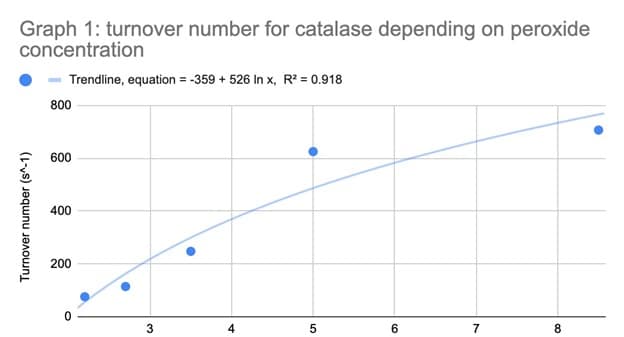
Part B:
Table #5 – Quantitative Analysis of the Effects of Freeze-Thaw Cycles on Liver Enzyme Activity Comparing the Number of Freeze Thaw Cycles, Balloon Circumference, Mass of Liver, and Balloon Volume.
| Number of Cycles | Mass of Liver (g) | Balloon Circumference (cm) | Balloon Volume (cm3) |
| 1 | 1.7 | 14.9 | 55.9 |
| 3 | 1.8 | 15.7 | 65.4 |
| 5 | 1.8 | 17.1 | 84.4 |
| 7 | 2.0 | 15.5 | 62.9 |
| 9 | 1.8 | 14 | 46.3 |
| Number of Cycles Mass of Liver (g) Amount of O2 Gas Produced (mmol) 1 1.7 2.25 3 1.8 2.64 5 1.8 3.41 7 2.0 2.54 9 1.8 1.87 |
Table #6 – Quantitative Analysis of the Effects of Freeze-Thaw Cycles on Liver Enzyme Activity Comparing the Number of Freeze Thaw Cycles, Mass of Liver, and Amount of O2 Gas Produced.
| Number of Cycles | Mass of Liver (g) | Amount of O2 Gas Produced (mmol) |
| 1 | 1.7 | 2.25 |
| 3 | 1.8 | 2.64 |
| 5 | 1.8 | 3.41 |
| 7 | 2.0 | 2.54 |
| 9 | 1.8 | 1.87 |
Table #7 – Quantitative Analysis of the Effects of Freeze-Thaw Cycles on Liver Enzyme Activity Comparing the Number of Freeze Thaw Cycles, Mass of Liver, and Rate of Reaction
| Number of Cycles | Mass of Liver (g) | Rate of Reaction (umol/s) |
| 1 | 1.7 | 37.6 |
| 3 | 1.8 | 43.9 |
| 5 | 1.8 | 56.8 |
| 7 | 2.0 | 42.3 |
| 9 | 1.8 | 31.2 |
Table #8 – Quantitative Analysis of the Effects of Freeze-Thaw Cycles on Liver Enzyme Activity Comparing the Number of Freeze Thaw Cycles, Mass of Liver, and Turnover Number
| Number of Cycles | Mass of Liver (g) | Turnover Number (s^-1) |
| 1 | 1.7 | 343.7 |
| 3 | 1.8 | 379.8 |
| 5 | 1.8 | 490.7 |
| 7 | 2.0 | 328.9 |
| 9 | 1.8 | 269.3 |

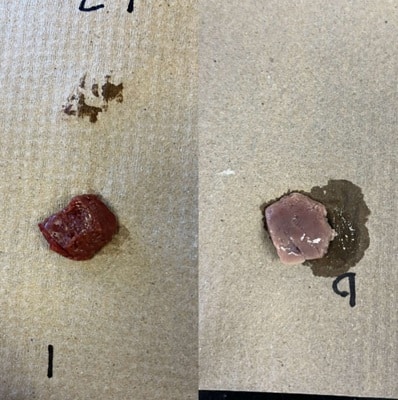
Figure 2: Comparison of liver after 1 freeze-thaw cycle (left) and 9 freeze-thaw cycles (right)
Calculations
Calculation #1 – Volume of Oxygen Gas Produced When Hydrogen Peroxide Concentration is 8.5%
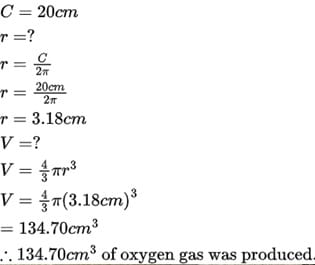
Calculation #2 – Number of Mols of Oxygen Gas Produced When Hydrogen Peroxide Concentration is 8.5% (Assume SATP)
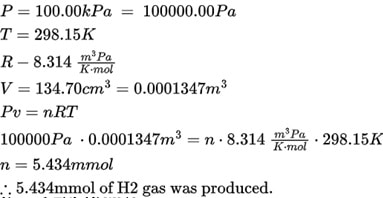
Calculation #3 – Rate of Reaction When Hydrogen Peroxide Concentration is 8.5%
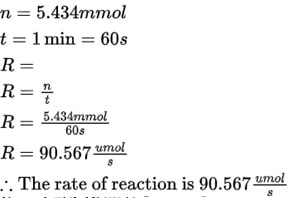
Calculation #4 – Amount of Catalase per Gram of Mouse Liver (W13)
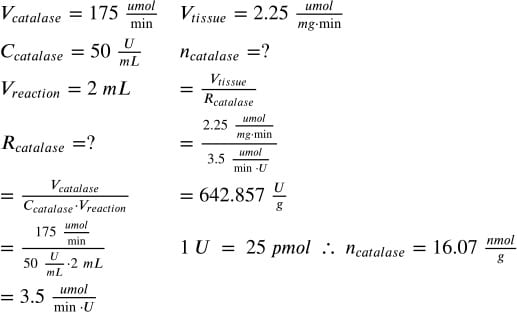
Calculation #5 – Turnover Number for Catalase

Conclusion:
Repeated freezing and thawing of the liver can affect the functioning of liver catalase.
Despite it being discovered that catalase is the most resistant against the freeze thaw cycles, catalase has its own optimal range (W26). Within this range the catalase is
slightly if not completely unaffected by the changes in temperature. However, there are temperatures in which the rate of catalase activity increases with temperature, until it reaches a point in which it becomes too high, and the rate of reaction will decrease (W21). This can be seen from the data in Table #6; as after only one freeze thaw cycle, only 2.25mmol of O2 gas was produced, which is the second smallest amount of O2 gas to be produced within the experiment.
The same can be said for temperatures in which are too cold for the rate of reaction to continue to increase, leading it to decrease as temperature decreases. As seen within Table #6; After a total of 9 freeze and thaw cycles, only 1.87mmol of O2 gas was produced, showing a large decrease in rate of reaction in the catalase in comparison to the large 3.41mmol of O2 gas produced after 5 freeze thaw cycles. It is believed that the optimum temperature for catalase function is around 25℃ (average chicken body temperature) (W19).
As the environmental temperature leans closer to the optimum temperature, hydrogen bonds loosen making it easier for catalase to act on hydrogen peroxide molecules. Now if the temperature increases or decreases beyond the optimum temperature range, (0℃ to 30℃) the enzyme will denature and its structure becomes disrupted (W28). As Catalase activity is only seen to increase from temperatures of 0℃ to 30℃, catalase activity is seen to decrease as it becomes disrupted in temperature ranges of 30℃ to 100℃ (W24).
This can be seen within the experiment through the viewing of the rate of reaction variations across the different amounts of freeze thaw cycles within Table 7. The rate of reaction appears to be the highest at 56.8umol/s, meaning the 5 freeze thaw cycles are likely the closest to the optimal temperature, and lower at 31.2umol/s (after 9 freeze thaw cycles) and 37.6umol/s (after 1 freeze thaw cycle), meaning these freeze thaw temperatures are too low and too high out of the data represented which allows for the most catalase reactivity to be the previously mentioned data.
In reference to the hypothesis and the data found through the experiment, the hypothesis in which as the number of freeze thaw cycles increases, the enzyme activity decreases, which was discovered through the experiment that indeed enzyme activity can decrease with temperature decrease, it can take a more extreme amount of colder temperature as well as a more extreme amount of warmer temperature, to see decreases in the rate of reaction.
Some issues that arose with the lab would be the delay in reaction for some of the variables as in some tests, the pieces of liver would get stuck on the side of the test tubes causing a potential disruption in the rate of reaction which could alter the results to show a different rate of reaction in relation to the freeze thaw cycles.
To modify this, an alternative to the procedure would have been to put the hydrogen peroxide in the balloon and the liver in the test tube rather than what was done in this procedure. An alternative factor that could have altered the results would be the small variation in mass of the different pieces of liver and how its mass and surface area could affect the effect of different freeze thaw cycles in comparison to other pieces with
different masses and surface areas, as well as different numbers of freeze thaw cycles. To alter this, something that can be done alternatively is to ensure that the mass of each different piece of liver has the exact same mass across all 5 pieces.
Diluting and increasing the concentration of a solution can affect the rate of catalase reaction as increasing the concentration can increase the rate of reaction until it reaches its optimal concentration or saturation in which it will then remain constant (W17). As well as, when a solution of liver catalase is diluted, the concentration of the enzyme is decreased. This means that there are fewer enzyme molecules available to catalyze the breakdown of hydrogen peroxide. As a result, the rate of the reaction will decrease. Increasing the concentration of the solution by adding more liver catalase will increase the number of enzyme molecules available to catalyze the reaction.
This will result in an increase in the rate of the reaction (W23). It can be noted that in reference to Table 3; it can be seen that as the concentration of the hydrogen peroxide increases, the rate of reaction also increases. This is further supported by the data collected and presented in Table 2; by the comparison of concentration of hydrogen peroxide, and the amount of oxygen gas produced by the reaction, as the higher amount of oxygen gas produced, the higher the rate of reaction is. In reference to the hypothesis, the date presented as a result of the lab further supports the hypothesis greatly as what was predicted to occur was
exactly what occurred within the lab shown through the results in Tables, 1-4; through the measured volume of the O2 gas filled balloon, the amount of O2 gas produced, the rate of reaction, as well as turnover number which is the formula that was predicted to fit with the results in the hypothesis. Some factors that would’ve potentially altered the data
found from this experiment would be the potentially delayed reaction due to the pieces of liver getting stuck on the sides of the test tube during each trial. This could’ve potentially changed the rate of reaction as the slow descent into the peroxide could’ve not only delayed the reaction, but decreased the amount of oxygen gas produced, a large factor in determining the success rate of the lab. Alternatively, what could be done to avoid this in the future would be to switch the placement of the liver and the peroxide. Instead of placing the liver in the balloon and the liquid in the test tube, what could potentially be better would be to place the liver in the test tube, and the peroxide in the ballon, so the liver can be fully immersed in the peroxide as soon as the balloon is attached to the test tube.
Discussion:
How might the lack of cold blooded animals in colder climates be related to the activity of enzymes in freeze thaw cycles?
For starters, cold blooded animals have a disadvantage over warm blooded animals as there is a temperature where the metabolism in cold blooded animals just will not work. Although it is noticeable that there are a few cold blooded animals that are active in the winter, the farther north you go, the fewer there will be (W27). This is due to what was
mentioned above. As well as, cold blooded animals are typically known to have a lower number of mitochondria per cell, which does not allow for them to generate heat through the increasing the rate in which they burn fats and sugars, a process that is possible for warm blooded animals (W18). This means that cold blooded animals are more heavily reliant on the temperature of the environment around them to keep them warm, whereas warm blooded animals are able to control and better maintain their internal temperature (W20).
How would enzyme activity vary across animals living in high pH environments versus low pH environments?
Knowing each enzyme has an optimum pH range, changing the pH to become outside of its optimal range can greatly slow enzyme activity, meaning the rate of reaction within the organism’s cells would greatly decrease (W22). This can be seen with animals living on land as the amount of pH within the land living organisms can greatly affect their rate of reaction within the organisms cells. This is why land living organisms cannot survive
dehydration, but can also suffer from overhydration as a lack of balance in pH can greatly reduce enzyme rate (W30). In contrast, with aquatic organisms external and internal levels of pH do not as greatly affect the rate of reaction within the organisms enzymes, what would alter the rate of reaction within the organism is higher temperatures as the organisms rate of reaction is all dependent on the temperature of their aquatic environment (W29). For reference, aquatic animals living within a higher climatic
aquatic environment would speed up the organism’s metabolic need for more oxygen, causing greater reduction in oxygen levels within their environments reducing the number of resources essential for aquatic life (W25).
References
(W1) Britannica. (2023, February 23). Chemical reaction | Definition, Equations, Examples, & Types. Encyclopedia Britannica. Retrieved March 26, 2023, from https://www.britannica.com/science/chemical-reaction
(W2) CDC. (2019, June 21). Hydrogen Peroxide | NIOSH. CDC. Retrieved March 26, 2023, from https://www.cdc.gov/niosh/topics/hydrogen-peroxide/default.html
(W3) Chemistry Learner. (2019, April 11). Home. YouTube. Retrieved March 26, 2023, from https://www.google.com/url?sa=i&url=https%3A%2F%2Fwww.chemistrylearner.com%2 Factivation-energy.html&psig=AOvVaw1cRZRjbfKzXa0UKbWzZEhD&ust=167985070 6416000&source=images&cd=vfe&ved=0CA0QjRxqFwoTCOjCntfJ9_0CFQAAAAAd AAAAABAD
(W4) Cleveland Clinic. (2021, May 12). Enzymes: What Are Enzymes, Pancreas, Digestion & Liver Function. Cleveland Clinic. Retrieved March 26, 2023, from https://my.clevelandclinic.org/health/articles/21532-enzymes
(W5) Cleveland Clinic. (2021, June 28). Elevated Liver Enzymes: What Is It, Causes, Prevention
& Treatment. Cleveland Clinic. Retrieved March 26, 2023, from https://my.clevelandclinic.org/health/symptoms/17679-elevated-liver-enzymes
(W6) Cook, G. (n.d.). The Science Behind Pyrex Glass | Pyrex. Pyrex Potluck. Retrieved March 26, 2023, from https://pyrex.cmog.org/content/science-behind-pyrex-glass
(W7) Helmenstine, A. M. (2019, July 3). How Cold Does Ice Get With Salt? ThoughtCo.
Retrieved March 26, 2023, from
https://www.thoughtco.com/how-cold-does-ice-get-with-salt-4017627
(W8) Libertpub.com. (2017, December 30). . . Libertpub.com. Retrieved March 26, 2023, from https://www.liebertpub.com/doi/10.1089/bio.2016.0023
(W9) Libre Texts. (2022, July 4). Catalytic Efficiency of Enzymes. Chemistry LibreTexts.
Retrieved March 26, 2023, from https://chem.libretexts.org/Bookshelves/Biological_Chemistry/Supplemental_Modules_(
Biological_Chemistry)/Enzymes/Enzymatic_Kinetics/Catalytic_Efficiency_of_Enzymes (W10) McGill University. (2017, January 18). Hydrogen Peroxide: the body’s best defence
system | Office for Science and Society. McGill University. Retrieved March 26, 2023, from
https://www.mcgill.ca/oss/article/general-science-you-asked/hydrogen-peroxide-bodys-be st-defence-system
(W11) Ontario.ca. (2007, January). Cold stress in cows | ontario.ca. Ontario.ca. Retrieved March 26, 2023, from https://www.ontario.ca/page/cold-stress-cows
(W12) Rogers, K. (2023, February 28). Denaturation | Definition, Examples, & Facts | Britannica. Encyclopedia Britannica. Retrieved March 26, 2023, from https://www.britannica.com/science/denaturation
(W13) Science Direct. (2019, April 11). Home. YouTube. Retrieved March 26, 2023, from https://www.sciencedirect.com/science/article/abs/pii/S0006291X16300262
(W14) Scientific American. (2012, March 8). The Liver: Helping Enzymes Help You! Scientific American. Retrieved March 26, 2023, from https://www.scientificamerican.com/article/bring-science-home-liver-helping-enzymes/
(W15) Statology.org. (2019, February 24). What is a Good R-squared Value? Statology. Retrieved March 26, 2023, from https://www.statology.org/good-r-squared-value/
Webstaurantstore. (2022, August 30). Knife Safety Tips: Handling & Cleaning Tips for the Kitchen. WebstaurantStore. Retrieved March 26, 2023, from https://www.webstaurantstore.com/article/51/knife-safety-tips.html
(W16) Young, M. (n.d.). Thermostable enzymes. PubMed. Retrieved March 26, 2023, from https://pubmed.ncbi.nlm.nih.gov/14543441/
(W17) Bartleby. (n.d.). How Substrate Concentration Affects a Catalase Enzyme… Bartleby.
Retrieved March 27, 2023, from
https://www.bartleby.com/essay/How-Substrate-Concentration-Affects-a-Catalase-Enzym e-PKSVWH6AZLEW
(W18) Bionity. (2002, April). Warm-blooded. bionity.com. Retrieved March 27, 2023, from https://www.bionity.com/en/encyclopedia/Warm-blooded.html
(W19) Burk, L. (2003). Purification and Partial Characterisation of Catalase from Chicken Liver and the Inhibition Effects of Some Chemicals on the Enzyme Activity. DergiPark.
Retrieved March 27, 2023, from https://dergipark.org.tr/tr/download/article-file/215078 (W20) Glicksman, H. (2016, April 30). Understanding Temperature: Cold-Blooded versus
Warm-Blooded Animals. Evolution News. Retrieved March 27, 2023, from https://evolutionnews.org/2016/04/understanding_t/
(W21) In Lee, J. (n.d.). How temperature affects the rate of enzyme activity. Table 2: Rate of enzyme activity between catalase and hydrogen peroxide for all 3 trials in different temperatures. Retrieved March 27, 2023, from https://www.rcboe.org/cms/lib010/GA01903614/Centricity/Domain/1472/IA%20How%2 0Temperature%20Affects%20the%20Rate%20of%20Enzyme%20Activity.docx
(W22) Khan Academy. (2019). Enzymes review (article). Khan Academy. Retrieved March 27, 2023, from
https://www.khanacademy.org/science/ap-biology/cellular-energetics/environmental-impa cts-on-enzyme-function/a/hs-enzymes-review
(W23) Libretexts.org. (2022, September 16). 15.2: The Rate of a Chemical Reaction. Chemistry LibreTexts. Retrieved March 27, 2023, from https://chem.libretexts.org/Bookshelves/Introductory_Chemistry/Introductory_Chemistry
/15%3A_Chemical_Equilibrium/15.02%3A_The_Rate_of_a_Chemical_Reaction
(W24) Mayfield Schools.org. (2014). Catalase Lab. Mayfield City Schools. Retrieved March 27, 2023, from https://www.mayfieldschools.org/downloads/catalase%20lab%202014%20key%2023.doc x
(W25) Ocean Washington. (2015, June 5). Warmer, Lower-oxygen oceans will shift marine habitats. UW Oceanography. Retrieved March 27, 2023, from https://www.ocean.washington.edu/story/Warmer_Loweroxygen_oceans_will_shift_mari ne_habitats
(W26) PubMed. (2005, October). Effect of multiple freeze-thaw cycles of cytoplasm samples on the activity of antioxidant enzymes. PubMed. Retrieved March 27, 2023, from https://pubmed.ncbi.nlm.nih.gov/16125630/
(W27) Rohrig, B. (2013, October). Chilling Out, Warming Up: How Animals Survive Temperature Extremes. American Chemical Society. Retrieved March 27, 2023, from https://www.acs.org/education/resources/highschool/chemmatters/past-issues/archive-201 3-2014/animal-survival-in-extreme-temperatures.html
(W28) Smith, B. (2018, April 30). How Does Temperature Affect Catalase Enzyme Activity? Sciencing. Retrieved March 27, 2023, from https://sciencing.com/temperature-affect-catalase-enzyme-activity-7776025.html (W29) Web.utk. (n.d.). Web.utk.edu. WFS 550 Fish Physiology – Metabolic Rate. Retrieved March 27, 2023, from http://web.utk.edu/~rstrange/wfs550/html-con-pages/w-metab.html
(W30) Worthington Biochem. (2023). Effects of pH. Worthington Biochemical. Retrieved March 27, 2023, from https://www.worthington-biochem.com/tools-resources/intro-to-enzymes/effects-ph

